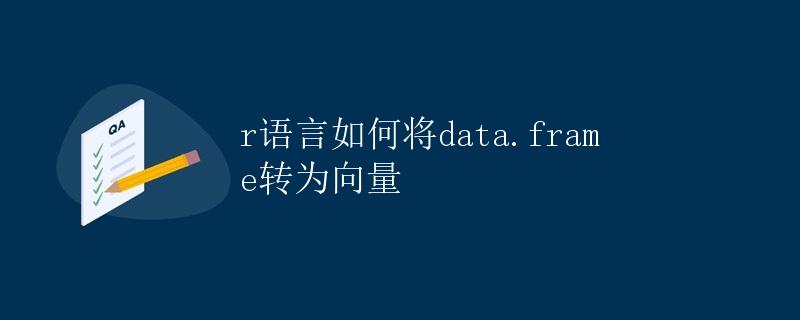R语言如何将data.frame转为向量

在R语言中,我们经常会处理数据集或者数据框(data.frame)的信息。有时候我们希望将data.frame的某一列或者多列转换为向量进行进一步的操作。在本文中,我们将详细介绍如何将data.frame转换为向量。
背景知识
在R语言中,data.frame是一种非常常用的数据结构,类似于Excel中的数据表格,由若干行和若干列组成。而向量是R语言中最基本的数据结构,可以存储一维的数据。将data.frame转为向量可以使得我们更方便地进行数据分析和统计操作。
将data.frame某一列转为向量
首先我们来看如何将data.frame中的某一列转为向量。假设我们有如下的一个data.frame:
# 创建一个data.frame
df <- data.frame(
id = 1:5,
name = c("Alice", "Bob", "Charlie", "David", "Emma"),
age = c(25, 30, 35, 40, 45)
)
# 打印data.frame
print(df)
运行以上代码,我们可以看到输出的data.frame内容如下:
id name age
1 1 Alice 25
2 2 Bob 30
3 3 Charlie 35
4 4 David 40
5 5 Emma 45
接下来,我们将data.frame中的name列转为向量:
# 将data.frame的某一列转为向量
name_vector <- df$name
# 打印向量
print(name_vector)
运行以上代码,我们可以得到输出的向量内容如下:
[1] "Alice" "Bob" "Charlie" "David" "Emma"
这样,我们就成功地将data.frame中的name列转为了向量。
将data.frame多列转为向量
除了将data.frame中的某一列转为向量之外,我们还可以将data.frame中的多列合并为一个向量。假设我们有如下的一个data.frame:
# 创建一个data.frame
df <- data.frame(
id = 1:5,
height = c(170, 180, 165, 175, 160),
weight = c(60, 70, 55, 65, 50)
)
# 打印data.frame
print(df)
运行以上代码,我们可以看到输出的data.frame内容如下:
id height weight
1 1 170 60
2 2 180 70
3 3 165 55
4 4 175 65
5 5 160 50
接下来,我们将data.frame中的height列和weight列合并为一个向量:
# 将data.frame的多列合并为向量
height_weight_vector <- unlist(df[c("height", "weight")])
# 打印向量
print(height_weight_vector)
运行以上代码,我们可以得到输出的向量内容如下:
height1 height2 height3 height4 height5 weight1 weight2 weight3 weight4 weight5
170 180 165 175 160 60 70 55 65 50
这样,我们就成功地将data.frame中的height列和weight列合并为了一个向量。
总结
通过本文的介绍,我们学习了如何在R语言中将data.frame转为向量。当我们需要对data.frame中的某一列或多列进行操作时,将其转为向量可以更方便地进行数据处理。
 极客教程
极客教程